When the water turns cold, certain materials perform better than others when it comes to fishing for finicky bass. Hair, either natural or synthetic, when attached to a jighead and fished in cold water often performs better that plastic or rubber. So fishing hair jigs for bass can be a great technique in the winter months.
Anglers have likely stumbled upon them at their local tackle retailers hundreds of times, paying them no mind as they proceed down the aisles to grab a pack of their favorite soft-plastics. Though seemingly simplistic and aesthetically bland, a hair jig is likely the most efficacious method for catching bass in northern waters when surface temperatures fall below 60 degrees. When implemented during the optimal time frame and fished properly, hair jigs produce monster limits of bass.
The tactic melds the art of fly tying with the practicality of conventional bass fishing, a concept few understand as well as Fred Wilson, owner of Flip Fly Tye jig company. The professional bass fishing guide and Spey-style fly-casting instructor many call Flippin’ Fred has been tying and fishing with hair jigs for more than 30 years. His knowledge of the different types of hair can improve your hair jig fishing this winter.
The Key to the Cold
From the late fall leading into the winter months and ice-out leading to the early spring are the times of the year the hair jig really shines. Spring or fall, the magic surface temperature range is between 40 to 55 degrees. The tactic allows anglers to attain a subtle and natural action that flawlessly mimics torpid prey in cold water.
“Hair’s ability to ‘breathe’ when saturated under water allows hair jigs to achieve the desired action with very little movement on the angler’s part,” Wilson said. “The natural pulsation of the hair when underwater is what makes hair jigs more effective in cold water situations than presentations which require anglers to impart action by continuously reeling or moving their rods. The metabolic rates of both bass and their prey decrease with plummeting water temps, and nothing can duplicate lethargic forage like a hair jig.”
That being said, the professional jig tier admits “not all hairs are created equal,” and that understanding the specific characteristics of the different styles of hair is critical in order to match the hatch on anglers’ local waters. Here is his take on how different hair moves and works.
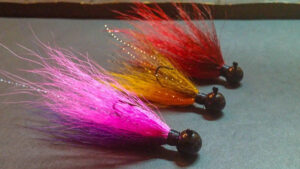
Buck Tail / Deer Body
Buck tail jigs are a popular choice for everything from panfish to large saltwater species. However, the material achieves the least amount of movement of all commonly used animal hairs. This material lays flat against the hook, resulting in a rapid rate of fall that can draw reaction strikes from slightly more aggressive bass. For this reason, Wilson elects to hold off on throwing straight buck tails until surface temps surpass the 50 degree mark. In order to slow the fall rate in extreme cold water scenarios, Wilson adds deer body hair to the front of his buck tails, which is a more cellular material than tail hair. A cellular material will absorb more water and when added to jigs tied with a moisture wicking hair, such as buck tail, will allow for a slower descent and increased flare.
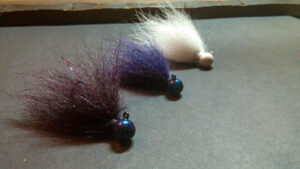
Fox
Wilson refers to fox hair as the “happy medium” due to its well balanced action. Though quite cellular, the material does not undulate in the water as readily as some animal furs and falls at a moderate rate, making it the perfect material to have tied on in any cold water situation. The professional guide notes that fox hair works particularly well on water bodies with a healthy baitfish population, such as his home waters of Candlewood Lake in southern Connecticut.
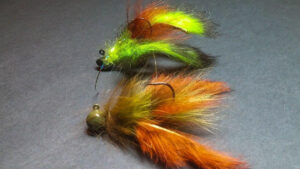
Rabbit
Who would’ve thought that the Easter Bunny could make for a killer jig. Rabbit hair often comes in strips of fur, and when tied by a skillful professional such as Wilson, these strips can be manipulated to effortlessly simulate the pinchers of a fleeing crawfish. Likewise, utilizing a single strip of rabbit fur on a jig can mimic the movements of a distressed leech. When saturated, rabbit hair flares, pulsates, and even slightly lifts off of the bottom. This very responsive material will yield greater results when fished just prior to the spawn when water temps have risen into the 55 to 60-degree range.
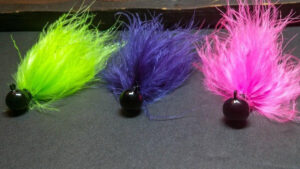
Marabou
The material which possesses the greatest rippling effect is unquestionably marabou, which billows underwater with the slightest movement of the rod tip. Unlike other materials, marabou’s overwhelming sensitivity and flare make it a very versatile option. When tight lipped bass want a bait that is sitting in one place, anglers can leave the jig on the bottom and, without moving the bait at all, still achieve a life like undulating motion in the hair itself. This presentation is a dead ringer for a baitfish feeding on the bottom in very cold water. Marabou can also be scooted along the bottom as the water begins to warm into the mid to upper 50’s, offering a unique finesse alternative to the popular suspending jerkbait.
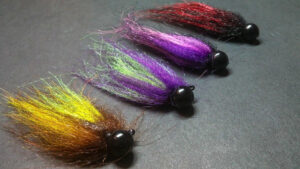
Synthetic
Synthetic hairs differ drastically in consistency and composition, and jigs tied with these materials can vary in motion and rates of fall. Wilson relies mostly on Punisher’s synthetic hair when tying his Flip Fly Tie specials, but emphasizes that each synthetic hair will have its own unique motion and anglers will need to experiment in order to determine the proper applications for hair manufactured by different distributors.
Rock Out
No matter the material, concentrating on rocky areas is absolutely key.
“If you’re not getting snagged up on the bottom and losing jigs occassionally, you’re likely not fishing in a productive area,” Wilson said.
In late fall and winter, Wilson beefs up the weight on his jigs to a ¼-ounce or greater as to better probe the rocky depths of wintering areas in 25 to 40 feet of water. During the prespawn, Wilson targets shallow rocky flats that are close to deeper water, picking off hungry bass on their migration to spawning grounds, typically with an 1/8-ounce hair jig.
Whether fishing a hair jig shallow for prespawn bass or on deep ledges and offshore structure for wintering fish, the presence of rock is essential, and a slow drag is the best retrieve for persuading inactive bass. Anglers should never head out on a mission for cold water bass without a solid stock of fur balls on hand.
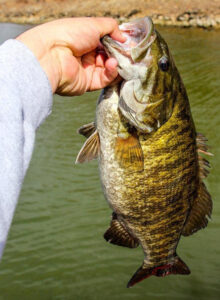
Gearing Up
In order to fish a hair jig properly, anglers must utilize light line and finesse tackle. Wilson relies on his Dobyn’s DX 742 SF medium-action spinning rod and Lew’s reel paired with 6-pound Gamma Edge fluorocarbon line to perfect his presentation. He insists that light fluorocarbon line is necessary in order to preserve hair jigs’ natural movement. The longer rod assists Wilson in covering more water and making longer casts to weary prespawn bass. Likewise, the parabolic bend of the medium-action rod assists in applying the perfect amount pressure when setting a light-wire hook.
When All Else Fails
Fishing with hair jigs may not appeal as much to anglers as well as high tech hard baits, but they can produce phenomenal results in the winter months. When the water becomes too cold for moving baits to be productive, fur balls often entice the quality bites other methods fail to produce. Several large manufacturers such as Punisher offer quality hair jigs, but local tiers such as Wilson who possess a greater knowledge of region specific forage may offer better alternatives.
As temperatures drop in the early winter, keep hair jigs in mind for your cold water bass fishing excursions.












